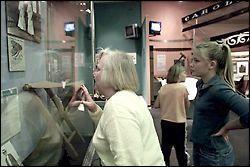 |
 |
| DEAN RUTZ / THE SEATTLE TIMES |
| Sandra Hamack takes her two granddaughters through the Metropolis150 exhibit at the Museum of History & Industry, giving them a narrative of her time and life in the process. The girls, from Snohomish, are Sarah McArthur, 13, right, and Katherine McArthur, 11, background. |
|
 |
The Museum of History & Industry's retrospective of 150 years of Seattle and King County history is neither an exercise in boasting nor an attempt at boosterism.
Instead, the Metropolis 150 exhibit, which opened this weekend, is an insightful study of the dichotomies and tensions that have shaped the community — uncomfortable though they may be.
Sure, Seattle has been about airplanes and hydroplanes, a World's Fair and a fair amount of rain. All of that is covered in Metropolis 150. But the educational exhibit is at its most compelling when it challenges visitors to critically assess what Seattle holds dear as its values, including its reputation as a city with open arms.
It raises those questions through conflicting images and artifacts. A display showing how Seattleites live includes ornate imported furniture as well as the soiled mattress and blanket of a homeless person. A salute to Seattle as a "world city" is contrasted by a handmade sign of a World Trade Organization protester. Icons and photos of successful home-grown retailers are placed around the corner from artifacts related to Seattle's general workers' strike of 1919. Tribute to a Japanese-American family that ran a confectionery store on South Main Street is balanced with attention to the internment of such families during World War II.
Metropolis 150's message is that little about the evolution of Seattle has been simple.
Seattle: 50 years at a time

 A lot of history has happened since the city of Seattle got its start 150 years ago on Alki Beach, and you can find much of it on your own. Here are some suggested sites. Choose an area of the city to visit and travel from place to place, decade to decade. A lot of history has happened since the city of Seattle got its start 150 years ago on Alki Beach, and you can find much of it on your own. Here are some suggested sites. Choose an area of the city to visit and travel from place to place, decade to decade.

1851-1901 1902-1951 1952-2001 |
|
"The past is a perilous place and that's what makes it so worthwhile to learn about," said Lorraine McConaghy, museum historian.
The exhibit is being launched as Seattle edges closer to the 150th anniversary of the arrival of pioneers at Alki Point on Nov. 13, 1851. The 150th anniversary of the creation of King County is in December 2002.
Metropolis 150 features hundreds of photographs and artifacts. It will be a permanent fixture at the Montlake museum and is included in the overall admission price.
The opening displays, focusing on Seattle's obsession with nature and civil engineering, present the most striking contradictions. Seattleites appreciate the rings of mountains and carpets of water that give the city its natural beauty.
Yet city fathers blithely altered the city's natural landscape in the name of convenience and order. That point is hammered home in rarely seen black-and-white amateur film footage shot by the contractor who regraded Denny Hill.
When barges in Elliott Bay, loaded with Denny Hill dirt, purposely tip over to dump city into the Sound, viewers of the film can't help but cringe.
The curators behind Metropolis 150 sought such a gut reaction, but they also make certain the dichotomy theme is not a total downer. Another display, for example, points out that engineering marvels also have enhanced nature by helping to sustain salmon runs.
Metropolis 150 also invites visitors to examine the city's frolicsome history in a contemporary light. A display focusing on "Century 21," the 1962 Seattle World's Fair, reminds that our future viewed back then is our present day. Seattle's "city of tomorrow" was supposed to include a weather-protective dome over downtown and islands of apartments in Lake Washington. (Not quite.)
Monorails were to be running throughout the city. (Still working on that.)
Displays include several surprises, including a photograph of a chest of drawers that was manufactured by a not-so-well-known furniture maker: Boeing. The company plied that craft during a post-World War I lull.
Hydroplane fans will enjoy seeing the beautifully restored hull of the Slo-Mo-Shun IV and the film footage of races from the golden era of the 1950s.
The exhibit also marks the return of the museum's periscope, which offers a 360-degree view from Montlake. First installed in 1964, and enjoyed by generations of Seattle schoolchildren, it was taken off display several years ago.
Metropolis is a Greek word meaning "mother city." Metropolis 150 is a good place to bring your mom, or dad or uncle or aunt or grandparent — any elders who grew up in Seattle and thus can offer their own personal histories to complement the displays.
"We call it history," McConaghy said. "But the people who lived through these experiences called it real life."
Stuart Eskenazi can be reached at seskenazi@seattletimes.com
|
 Sunday, October 1, 2001 - 12:00 a.m. Pacific
Sunday, October 1, 2001 - 12:00 a.m. Pacific
